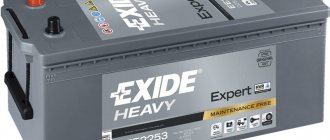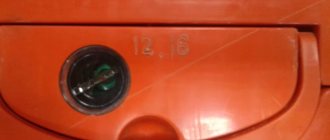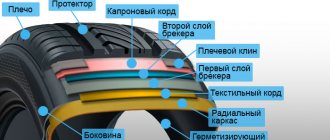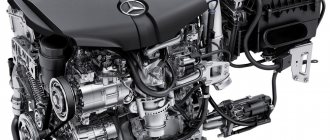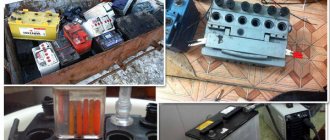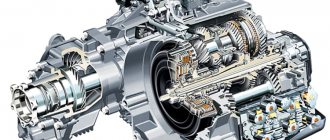Each battery manufacturer puts a special code on its battery, which is called a marking. Technologically, markings can either be burned out with a laser (like the markings on Tyumensk-Medved), or melted into cliches (like Kursk batteries). As a rule, the release date is marked upon the battery’s readiness, that is, it is factual, but in practice, some factories sin and put a release date from the future, which allows them to sell batteries even if they were produced 2 months ago. Most likely, this is done in the summer-autumn period in order to optimally load production and stock up on batteries for the season.
It is believed that the fresher the battery, the higher its cost, so they often try to get rid of old batteries at low attractive prices. During storage, the battery loses part of its capacity due to chemical processes occurring inside. For example, batteries made using hybrid technologies can be stored for 6 months without loss of quality, calcium batteries – 12 months. At the same time, Johnson Controls (manufacturer of Varta, Bosch, Energizer and other brands) reports that their batteries can be stored for 18 months. In fact, this is only a marketing ploy and a tool to make it easier for dealers to sell “stale” batteries that reach store shelves through a long route.
Therefore, when planning to purchase a new battery, be sure to take a printout of the battery production date markings to the store. This will allow you to make the right choice.
In addition to marking production dates, batteries have markings in accordance with accepted standards (GOST, SAE, DIN, EN, JIS), which our site will write about a little later.
This article provides examples of markings used since 2014, since in 2015 there were serious changes in the battery market, and some owners of private brands changed manufacturing plants.
- Forse, FB, FireBall, Uno, Dominator, Kursk battery
- Tyumen bear, Tyumen Batbear, Arctic Batbear, Yamal
- Aktech, Orion, Beast
- Cobat, Titan (Standard, Euro Silver, Arctic Silver, Asia Silver, Vaiper)
- VARTA, BOSCH
- Mutlu
- Panasonic, Furukawa Battery (SuperNova)
- Topla, Moratti
- Banner
- Atlas, Bost, Numax
- Akom (Forward, Bravo, Reactor)
- Bars, Unikum (Kainar)
- Tyumen Battery Plant (Tyumen Battery batteries)
- How to find out the year and month of manufacture for batteries E-Lab, Razor, MAQ, Onics, Odin and others from the Bars Technology factory
- Battery marking European standard EN
- American standard SAE J537
Forse, FB, FireBall, Uno, Dominator, Kursk battery
The marking code is applied to the battery cover and includes:
battery production date,
information about the battery and production conditions.
The code consists of two groups of numbers: the first group has four digits, the second group has six digits: 1234 567890.
Marking scheme:
1 – production line number
2, 3, 4 – individual batch code
5 – last digit of the year
6 – half year
7 – serial number of the month in the half-year
| First half of the year | Second semester | ||
| 1 | January | 1 | July |
| 2 | February | 2 | August |
| 3 | March | 3 | September |
| 4 | April | 4 | October |
| 5 | May | 5 | November |
| 6 | June | 6 | December |
8.9 - day (day of the month)
0 — brigade number (2 digits possible)
Marking example:
2260 311321
Explanation:
The battery was produced on production line No. 2, 260 - individual batch code. Date of manufacture: 2013, 1st half of the year, 1 month, 21st (January 21, 2013). Brigade No. 1
In connection with the transfer of production to the Kursk plant, the labeling system has been changed since 2015:
Example: 0713 1 25346 0713 is the production date of the battery, where 07 is the month, 13 is the shift number 25346 is the serial number of the manufactured battery. The serial number is reset to zero at the beginning of each month.
The heavy group of batteries is marked slightly differently.
An example of marking a heavy battery group:
14010243
Explanation:
The battery has a capacity of 140 A/h, produced in 2010, 2nd half of the year, 4th month of the second half of the year (October), by brigade No. 3.
Why do you need to know the release date of your battery?
The code on the battery case of many manufacturers includes the batch number, country, plant and city of production, conveyor number, production date of day, month and year, and other important information. It is applied primarily for internal use so that the batch number can be easily identified and, in case of defects, quickly removed from the tape. The code is also important for store personnel, especially when they are contacted with a complaint and need to conduct an independent examination of the technical condition of the device. The marking can also serve the buyer well if he needs to find out the release date and determine how long the device was idle in the warehouse. It happens that the conditions for storing a battery in a warehouse are extremely far from ideal and the last thing they pay attention to is the period from the date of manufacture. Getting the battery to the store was also not without some “adventures”. In other words, before ending up in its rightful place under the hood, another battery can endure a lot of hardships, so the less time has passed since the release date, the better for the condition of the battery.
Different batteries have their own periods of storage without use, but the period of inactivity from the date of production for obsolete serviced antimony and low-antimony ones is only six months. More advanced maintenance-free batteries with calcium added to the plates can be stored without recharging for a whole year. A calcium battery with silver alloyed plates can last 12-18 months from the date of manufacture. But even during this period, many chemical processes will occur inside the battery that will affect the condition and performance characteristics. This period is only recommended, and it would be better to get a newer device. Even the best AGM batteries will not be able to maintain all their characteristics for longer than two or three years and will “run out” forever.
To find out the release date of the battery, it is important to decipher the code of letters and numbers, which is drawn on the top section of the box using a laser, or can be indicated on a label or on a special sticker. Each manufacturer has its own principle for encrypting a number; there is simply no single method, because even within the same company the code can change.
Please note: if there is no manufacturing data on the battery case at all or the release date is difficult to read, be careful not to take such a device. Most likely you are looking at a counterfeit product that will not last long.
Tyumen Battery Plant (Tyumen Battery batteries)
The first two digits are the month of production, the next two are the year, the next two are the month, and the last digit is the shift.
Gillette Magico, Extra Start, Graisburg, Golden Horse, Asian Horse, Black Horse, Power Horse, White Horse SOMBOR battery factory (Serbia)
Place of marking on the cover: 1,2 - last digits of the year, 3,4 - week of the year, 5,6 - service information. Example: 115022 - 2011, week 50 (end of December).
Pilot, Pilot Silver, Elektroistochnik LLC "Elektroistochnik", Russia, Saratov
The place where the marking is applied is the top cover of the case. Example: ZALITA 0512 (May 2012).
Zubr LLC JV "Polesskie Batteries"
The location of the marking is the upper left corner of the battery cover. Example: 2G03E1. 2 – 2012, G – month (July), 03 – date, E – assembly line, 1 – capacity code (55 Ah). (A–January, B–February, C–March, D–April, E–May, F–June, G–July, H–August, J–September, K–October, L–November, M–December)
How to find out the production date of a battery
Varta
Deciphering the battery markings from a German company is the most difficult, primarily due to the contradictory code number. Manufacturing information is indicated in the lower left corner of the cover or on the front wall of the case. We are looking for a 13-digit VIN code that is melted onto the plastic surface of the battery. The marking can be continuous, with numbers and letters following each other, or with a small gap. The peculiarity of this company is that in 2014 its labeling changed, so before drawing conclusions regarding the numbers, you will first need to determine the generation of the battery.
The production date of the Varta battery, manufactured before 2014, is hidden in the code, starting with the fourth character. For example, we need to decipher the code A3V009112 0234. The first markers indicate the country of production (And this is Austria), the number 3 indicates the number of the conveyor from which the battery came off, and the letter V says that this product is intended to be sent to retail stores. We are interested in the following five values:
- The number 0 indicates the year of manufacture. This is the last digit of the year, i.e. meaning 2022.
- Next comes the month of production. The number 09 is the serial number of the month or September.
- Then the day is indicated: the number 11 is similar to the 11th number.
This battery was released on September 11, 2022, which means you can buy this one with confidence. Until 2013, on some Varta battery models, the manufacturing date was indicated by a colored circle, which was placed next to the logo on the label. Each color represents a different quarter of a particular year. Nowadays such marking is practically not used.
If you have a new generation of Varta battery in front of you (since 2014), then the decoding principle with which we find the release date is somewhat different. For example, code C1V9602362771, where again C is the country of origin (C is the Czech Republic), Number 4 is the conveyor number, V is shipping to retail. This time we are interested in characters 4 through 8, where:
- Digit 9 = 2022 year of battery manufacture;
- The number 60 indicates the month of production. In this case, you need to keep in mind that each number corresponds to its own month:
17 – January;
- 18 – February;
- 19 – March;
- 20 – April;
- 53 – May;
- 54 – June;
- 55 – July;
- 56 – August;
- 57 – September;
- 58 – October;
- 59 – November;
- 60 – December.
Judging by the indicated number, the battery came off the assembly line on December 23, 2019. This battery is already somewhat older than the previous one, but this does not mean that it has completely exhausted its resource. Battery downtime is different for each type.
If you happen to have a device that was made specifically for factories and car dealers, then the production date is marked there on the negative terminal in the form of a four-digit code, two of them on the bottom (year of production), two on top (week serial number from 01 to 52).
However, among Varta batteries there may be a four-digit code, in which case it is impossible to decipher it without a special table. You can find the number in the lower right part of the battery.
Let's take the IZFD label as an example.
The first character is the year and month the battery was manufactured.
| Year | January | February | March | April | May | June | July | August | September | October | November | December |
| 2015 | Y | Z | A | B | C | D | E | F | G | H | I | J |
| 2016 | K | L | M | N | O | P | Q | R | S | T | U | V |
| 2017 | W | X | Y | Z | A | B | C | D | E | F | G | H |
| 2018 | I | J | K | L | M | N | O | P | Q | R | S | T |
| 2019 | U | V | W | X | Y | Z | A | B | C | D | E | F |
| 2020 | G | H | I | J | K | L | M | N | O | P | Q | R |
| 2021 | S | T | U | V | W | X | Y | Z | A | B | C | D |
| 2022 | E | F | G | H | I | J | K | L | M | N | O | P |
| 2023 | Q | R | S | T | U | V | W | X | Y | Z | A | B |
| 2024 | C | D | E | F | G | H | I | J | K | L | M | N |
| 2025 | O | P | Q | R | S | T | U | V | W | X | Y | Z |
In our case, this is January 2022.
The second symbol indicates the plant where the battery was produced: E – Burgos (Spain), G – Guardamar (Spain), C – Ceska Lipa (Czech Republic), H – Hanover (Germany), Z – Zwickau (Germany), F – Sarguemines (France).
The third symbol is the day the battery was released.
| 1 | 2 | 3 | 4 | 5 | 6 | 7 | 8 | 9 | A | B | C | D | E | F | G | H | I | J | K | L | M | N | O | P | Q | R | S | T | U | V | |
| day | 1 | 2 | 3 | 4 | 5 | 6 | 7 | 8 | 9 | 10 | 11 | 12 | 13 | 14 | 15 | 16 | 17 | 18 | 19 | 20 | 21 | 22 | 23 | 24 | 25 | 26 | 27 | 28 | 29 | 30 | 31 |
For us it's the 15th.
The fourth character is the shift number (2/1).
That is, judging by the code, the battery was made on January 15, 2022 in the German city of Zwickau, shift number 2/1.
Aktex
I made the release date as easy to understand as possible and put the numbers in the center of the battery cover. Special tables and reference books for decoding are unnecessary here, since the marking principle here is the serial number of the month and the last two digits of the year. For example, code 1119 means that the battery was manufactured in November 2019.
Multu
On batteries from the Turkish company Mutlu, the code is indicated on the upper section of the case or on the left side of the cover using laser technology.
There are only six digits: 160625. Here, too, no complex tables are required for decryption, since:
- The first digit of the code is the production line number;
- The second is the year of manufacture of the battery;
- The third and fourth digits are the serial number of the month of manufacture;
- The fifth and sixth are numbers.
Those. on a Turkish battery the production date is read from right to left, and it turns out that it was assembled on line number 1 dated June 25, 2016.
Bison
Belarusian batteries are marked with a laser in the upper left corner right on the cover. The marking consists of six characters, including numbers and letters:
- The first character is the last digit of the year of manufacture;
- The second is the month of manufacture (A – January, B – February, C – March, D – April, E – May, F – June, G – July, H – August, J – September, K – October, L – November, M - December).
- The third and fourth are responsible for the number;
- The fifth character is the number of the production line on which the battery was assembled;
- The sixth is the capacity code.
If we have in our hands a battery marked 8H29E1, then, after checking the data, we can easily read that the battery has a release date of August 19, 2022, it was made on the E production line with capacity code 1, which corresponds to 55 A/h.
Topla and Tab
Slovenian Topla and Tab batteries have two options for marking the release date. The 7-digit code is laser-etched on the cover and is located on the body next to the positive terminal, for example: S317090. We are interested in numbers three to six. The label should be read as follows:
- The third and fourth digits indicate the year of manufacture.
- The fifth and sixth are the week number in order (from 01 to 52).
This means that the battery was assembled in March 2022 (week 9).
There is also a six-digit code for Topla, where two separate digits indicate the year of manufacture, and two more indicate the week. For example, F2 1615 says that the battery came off the assembly line in April 2016 (week 15).
Asian Horse and Black Horse
The marking of a Serbian pair of batteries from the Sombor company is formed according to a single principle. The six-digit code is located on the near side of the cover.
We are interested in four digits from the beginning - this is the year of manufacture and the serial number of the week (from 01 to 52). For example, marking 190219 indicates January 2019 (week 2).
Exide
The Exside battery differs from most manufacturers in that the code is contained on a special colored sticker, which is located on the top of the case cover. The release data is as concise as possible, since there are only two characters - one number and one letter. The number indicates the year of production, the letter indicates the month.
For example, on a round label we see code 6A. Number 6 = 2016, respectively 7 = 2022, 8 = 2022, etc. A = January, similarly B stands for the month of February, C = March, D = April, etc. up to L or December.
| Jan. Feb. | March Apr. | May June | Jul Aug. | Sep. Oct. | Nov. Dec. | |
| 2015 | 5A | 5B | 5C | 5D | 5E | 5F |
| 2016 | 6A | 6B | 6C | 6D | 6E | 6F |
| 2017, etc. | 7A | 7B | 7C | 7D | 7E | 7F |
In our case, the 6A marking means that the battery was made in January 2016.
However, from 2022, it was decided to abandon round stickers and the traditional code appeared on batteries of this brand, engraved directly on the case cover. Despite this, the decryption method remains the same:
- The number indicates the year of manufacture: 9 = 2022, and 0 = 2022, etc. for future years.
- The letter replaces the months of manufacture: A = January, B = February, etc. to L (December).
If we see two symbols 0 and C on the cover, we already know that the battery production date is March 2022.
Bosch
Car batteries from the famous Bosch company use a long code of 24 characters (letters and numbers), which indicate the conveyor number, shift, country of production, etc. We look for it on the lower left corner of the lid.
We are not interested in all the meanings of the marking; within the framework of our topic, we will look at the fourth, fifth and sixth digits. The first one indicates the year of manufacture, the other two are responsible for the month. If everything is more or less clear with the year - this is its last digit, then the table will help with the month:
| Year | January | February | March | April | May | June | July | August | September | October | November | December |
| 2014 | 417 | 418 | 419 | 420 | 453 | 454 | 455 | 456 | 457 | 458 | 459 | 460 |
| 2015 | 517 | 518 | 519 | 520 | 553 | 554 | 555 | 556 | 557 | 558 | 559 | 560 |
| 2016 | 617 | 618 | 619 | 620 | 653 | 654 | 655 | 656 | 657 | 658 | 659 | 660 |
| 2017 | 717 | 718 | 719 | 720 | 753 | 754 | 755 | 756 | 757 | 758 | 759 | 760 |
| 2018 | 817 | 818 | 819 | 820 | 853 | 854 | 855 | 856 | 857 | 858 | 859 | 860 |
| 2019 | 917 | 918 | 919 | 920 | 953 | 954 | 955 | 956 | 957 | 958 | 959 | 960 |
| 2020 | 037 | 038 | 039 | 040 | 073 | 074 | 075 | 076 | 077 | 078 | 079 | 080 |
| 2021 | 137 | 138 | 139 | 140 | 173 | 174 | 175 | 176 | 177 | 178 | 179 | 180 |
| 2022 | 237 | 238 | 239 | 240 | 273 | 274 | 275 | 276 | 277 | 278 | 279 | 280 |
| 2023 | 337 | 338 | 339 | 340 | 373 | 374 | 375 | 376 | 377 | 378 | 379 | 380 |
| 2024 | 437 | 438 | 439 | 440 | 473 | 474 | 475 | 476 | 477 | 478 | 479 | 480 |
| 2025 | 537 | 538 | 539 | 540 | 573 | 574 | 575 | 576 | 577 | 578 | 579 | 580 |
| 2026 | 637 | 638 | 639 | 640 | 673 | 674 | 675 | 676 | 677 | 678 | 679 | 680 |
| 2027 | 737 | 738 | 739 | 740 | 773 | 774 | 775 | 776 | 777 | 778 | 779 | 780 |
| 2028 | 837 | 838 | 839 | 840 | 873 | 874 | 875 | 876 | 877 | 878 | 879 | 880 |
| 2029 | 937 | 938 | 939 | 940 | 973 | 974 | 975 | 976 | 977 | 978 | 979 | 980 |
If we take the code S4V858243... etc., we will read that the Bosch battery was released in October 2022.
Iskra Energy
A long list of letters and numbers is located on the top of the battery cover. There are a total of 24 symbols of letters and numbers on the surface. For example, the marking H3V9010363563, where the opening letter is the country of origin (H - Germany), then comes the conveyor number and shipping parameters - these three characters are not very important in this article and we will not fully disclose the decoding method. The fifth, sixth and seventh digits are of interest, followed by service information again. The first digit means the year of manufacture, the second two months in order. In this case, code 901 says that the Iskra Energy battery was released in January 2022.
Beast
The “Beast” battery from a Russian manufacturer is marked using a laser. The marking is applied to the lid and consists of only four numbers, which are simply an abbreviated version of the release date. Two digits are the month, the second pair are the last two digits of the year.
For example, code 0417 couldn’t be easier to read: 04 indicates the month, 17, respectively, the year. The device was assembled in April 2022.
Titan
The production date can be found on the battery cover in the form of a laser code. There are only five characters consisting of letters and numbers. Deciphering will not be difficult:
- The first digit is the day of the week (from 1 to 7);
- The second and third indicate the week number (from 01 to 52);
- The fourth is responsible for the year of manufacture and is written as a letter of the Latin alphabet: N (2013), Z (2014), P (2015), A (2016) S (2017), T (2018), X ( 2019), L (2020).
- The fifth digit is the number of the shift that worked on the battery.
Let's take the battery with number 249X2 and see that it was manufactured on Tuesday in the 49th week (December) in 2022 and work shift number 2 is responsible for it.
Hankook
The Korean company Hankook produces not only high-quality tires, but also batteries for cars. They use a 6-digit digital pass code that is located on the cover of the device.
For example, the owner of the battery can observe the following group of numbers: 0DCK14:
- The first of them means the year;
- – serial number of the month (A – January; B – February; C – March; D – April; E – May; F – June; G – July; H – August; I – September; J – October; K – November; L - December).
Judging by the data indicated, the Hankuk battery left production in April 2022.
Tyumen Battery
Car batteries from the Tyumen Battery Plant are marked with laser engraving with a seven-digit code. The necessary symbols are located on the wall of the case - directly above the label with the image of a moose, or on the opposite side of the case. There are seven digits in total in this code:
- The initial two indicate the month the battery was produced;
- The third and fourth digits are the year of manufacture;
- The fifth and sixth are the day;
- The seventh digit is the number of the team that worked on the production of the device.
If we take a battery marked 112021 3, we will read the build date as November 21, 2022.
Tudor
Portuguese batteries, which have recently been assembled in Belarus, are marked with a 10-digit list of letters and numbers, which without special explanation will tell a third party little. You need to look for them on the upper section of the box lid. For example, we have a code in the form AF12KTJ23С, where only the second and last character, which indicate the date, is of interest. The second letter indicates the year of manufacture:
- A – 2013;
- B – 2014;
- C – 2015;
- D – 2016;
- E – 2017;
- F – 2018;
- G – 2019;
- H – 2022.
The last letter indicates the month of battery production, which is calculated in a similar way:
- A – January;
- B – February;
- C – March;
- D – April;
- E – May;
- F – June;
- G – July;
- H – August;
- I – September;
- J – October;
- K – November;
- L – December.
This means, judging by the code, the manufacturing date of the Tudor battery is March 2018.
Tesla
The Serbian company, which took the proud name Tesla, has markings on the top of their battery cover. It consists of six digits, where the first two are responsible for the year of manufacture, the next two digits indicate the serial number of the week (from 01 to 52), then there are service data that is not important to us now. For example, the marking 200514 means that the Tesla battery was released in the fifth week (beginning of the month of February) of 2022.
Battery markings
In addition to the encrypted release date, there is also a basic marking on the battery. It encodes the starting characteristics and design of the housing. First, let's look at the existing labeling standards.
GOST RF 2002 (outdated, new below from 2008)
6ST-60APZ
6 — indicates the number of cells in the battery
ST - means that the batteries are designed to start the engine, i.e. is a starter
60 — indicates the battery capacity in Amp hours.
A - battery with a common cover.
P - Packaged separator made of polyethylene (M - miplast, but they have not been produced for a long time)
Z - Flooded
European standard EN
5 55 065 042
- Indicates the range of capacity values of a 12-volt battery: (5 – from 1 to 99 Ah; 6 – from 100 to 199 Ah; 7 – from 200 to 299 Ah)
- Battery capacity, Ah (55, 60, 66, 77)
- Battery performance information
- Cold cranking current (in this case 420 A)
Decoding battery markings from different manufacturers
As you can see, the date of manufacture of the battery is indicated in different ways. The lack of a unified standard makes it very difficult to find and decipher this information; in the vast majority of cases, it is impossible to check the year and month of battery production without using the appropriate reference materials.
What can I say, if even experienced battery technicians are often forced to use such tables depending on the car and the installed battery. However, they formally have no need to obtain this data, but this information is important for the buyer. However, if desired, the necessary data can be easily found on the Internet using a smartphone or other mobile gadget. The main thing is to remember that when purchasing, such a check will not hurt.
Foreign manufacturers.
Slovenian batteries TAB, Topla, Moratti
On the presented units, the code can be read by a laser device at the top of the case. It has 14 characters, “3” and “4” denote the year, “5” and “6” the week.
The device was released in the 6th week of 2022.
Marking for Topla with four characters:
“1”, “2” – battery release;
Sample: F2 1915
We decipher: 19 is a year, 15 is a week.
Japanese Panasonic, Furukawa Battery (SuperNova)
The code in “Japanese” is punched on the lid. On Panasonic it is painted, format YY.MM.DD. On Furukawa Battery it can be read on a sticker, format DD.MM.YY.
We decipher: the battery was manufactured on August 9, 2017.
Batteries Exide, Centra.
The code in the presented batteries is printed on a round gray label, which is glued to the case cover. The code consists of one number and one letter, where the number means the year of manufacture (7-2017, 8-2018, 9-2022), and the letter means the month (A - for January, B - for February, C - for March, etc. .).
Korean batteries ALASKA, TOTACHI SOLITE
The marking area for Korean units is the upper part of the 7BKD706 format cover. 1st digit – year of manufacture, 2nd digit, month 3rd – country of manufacture.
The remaining numbers do not have much meaning: line number, production change, manufacturer designation, etc.
Batteries Varta, Bosch, Gigawatt, Energizer, etc. Batteries manufactured by Johnson Controls holding company
The Warta or Bosch code has 24 characters and is stamped on the top cover.
We are not interested in all the symbols of the code; we will decipher only those indicating the country of production and the date of issue. Saran production is indicated by the 3rd symbol. The release date is indicated by the fourth, fifth and sixth characters of the code.
The presented decoding will help you quickly understand the characteristics of the batteries. This information will be very useful and educational for car enthusiasts.
Information site about energy storage devices
When buying a new starter battery for a car, you need to carefully check not only the characteristics, but also the production date of the battery. Are you assured that modern batteries hold a charge for a long time under storage conditions, the date of manufacture is an irrelevant parameter? But the chemical reaction is continuous and accelerates if the battery is not stored properly. Perhaps the battery will last the warranty period, but will it last for the stated period?
Differences between standards
Before moving directly to the question of what the markings on the battery mean, you need to know the following. On Russian batteries, the “plus” is located on the left terminal, and the “minus” on the right (if you look at the battery from the front, from the sticker side). On batteries manufactured in Europe and Asia (in most cases, but not always) the opposite is true. As for American standards, both options are found there, but more often the European one.
Car battery polarity and standard
In addition to the marking of car batteries, they also differ in terminal diameters. Thus, the “plus” in European products has a diameter of 19.5 mm, and the “minus” - 17.9 mm. Asian batteries have “plus” with a diameter of 12.5 mm, and “minus” - 11.1 mm. The difference in the diameter of the terminals was made to eliminate errors associated with connecting the batteries to the vehicle's on-board electrical network.
In addition to capacity, when choosing a battery, it is necessary to take into account the maximum starting current for which it is designed. The marking of a car battery does not always contain a direct indication of such information, and may be designated differently in different standards; each standard has its own nuances.
The so-called cold cranking current is the starting current at a temperature of -18°C.
American standard
Designated SAE J537. Consists of one letter and five numbers. They mean:
- Letter . A - car battery.
- First and second digits . They indicate the number of the size group, and also, if there is an additional letter, the polarity. For example, the number 34 means belonging to the corresponding group. According to it, the battery size will be 260x173x205 mm. If there is no letter R after the number 34 (in our example), it means that the polarity is direct; if it is, it is reversed (respectively, “plus” on the left and right).
- Last three digits . They directly indicate the value of the cold cranking current.
An interesting point is that in SAE and DIN standards the starting currents (cold cranking currents) are significantly different . In the first case this value is greater. To convert one value to another you need:
- For batteries with a capacity of up to 90 Ah, SAE current = 1.7 × DIN current.
- For batteries with capacities from 90 to 200 Ah, SAE current = 1.6 × DIN current.
The coefficients were chosen empirically, based on the practice of motorists. Below is a table of the correspondence of cold start current for batteries according to different standards.
| DIN 43559 (GOST 959-91) | EN 60095-1 (GOST 959-2002) | SAE J537 |
| 170 | 280 | 300 |
| 220 | 330 | 350 |
| 255 | 360 | 400 |
| 255 | 420 | 450 |
| 280 | 480 | 500 |
| 310 | 520 | 550 |
| 335 | 540 | 600 |
| 365 | 600 | 650 |
| 395 | 640 | 700 |
| 420 | 680 | 750 |
